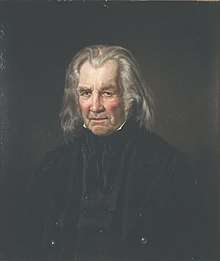Ole Rasmussen Apeness
Ole Rasmussen Apeness (11 February 1765 – 14 February 1859) was a Norwegian district sheriff, soldier, and farmer. He served as a representative at the Norwegian Constitutional Assembly.[1]

From DigitaltMuseum
Ole Rasmussen Apeness was born at Borre in Vestfold, Norway. Apeness was associated Haugean pietistic state church reform movement. He became a soldier in 1783 and participated as a non-commissioned officer in the campaign against Sweden in 1788. In 1794 he became sheriff in Borre, a post he held for 30 years. From 1808 to 1845 he was with the Conciliation Commission (Forlikskommisjon). In 1794, he was married to Elen Marie Hansdatter (1775–1818). In 1789, he bought the family farm from his mother where he and his wife raised their seven children. In 1819, his farm, Apenesgården, was purchased for use as Karljohansvern, the main base for the Royal Norwegian Navy in Horten from 1819 to 1963. In 1824 he bought a farm in Sem and stayed there the rest of his life.[2][3][4]
He represented Jarlsberg Grevskab (now Vestfold) at the Norwegian Constituent Assembly in 1814. Together with his fellow delegates, Herman Wedel-Jarlsberg and magistrate Gustav Peter Blom, he supported the position of the union party (Unionspartiet).[5][6]
References
- Apeness, Ole Rasmussen (Eidsvollsmann)
- Forlikskommisjon (lokalhistoriewiki.no)
- "Apeness-slekten, gården og dens omgivelser (Kjell Jakobsen, Borreminneredaksjonen)". Archived from the original on 2014-10-20. Retrieved 2015-06-09.
- "Verner veiminner i Horten på feil historisk grunnlag (Jan Ingar Hansen)". Archived from the original on 2016-03-04. Retrieved 2015-06-09.
- Unionspartiet (Norsk partipolitisk leksikon)
- "Ole Rasmussen Apeness". Store norske leksikon (in Norwegian). Oslo: Kunnskapsforlaget. Retrieved 23 March 2011.
Related Reading
- Holme Jørn (2014) De kom fra alle kanter - Eidsvollsmennene og deres hus (Oslo: Cappelen Damm) ISBN 978-82-02-44564-5